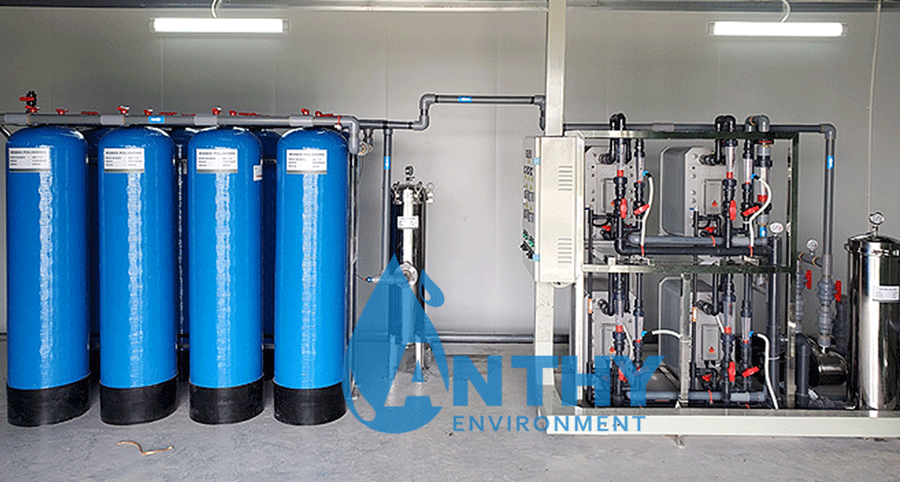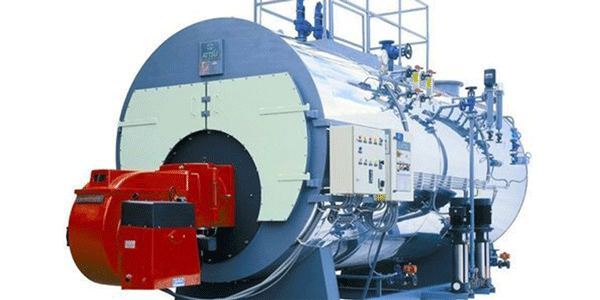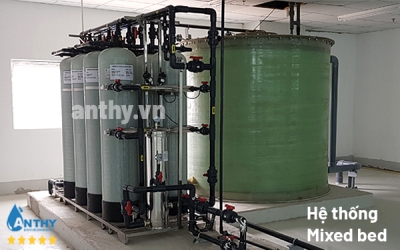DI water technology

Demineralized DI Water is a demineralization technology solution that produces ultrapure water with high economic efficiency in removing minerals and impurities from water to produce high purity water used in industries such as electronics, pharmaceuticals and laboratories, food and power generation where purity of water is very important. These technological processes will remove all dissolved solids, such as sodium, silica, alkalinity and mineral anions (Cl¯, SO4²¯, NO3¯). The DI systems manufactured by An thy are applied intelligent technology to operate automatically and close, for easy operation and maintenance.
Let's learn more about the operating principles and applications of the DI water filter system in production with the article.
What is demineralized DI water?
Demineralized water, also known as deionized water, is water that has had essentially all inorganic salts removed and most of the mineral content removed by various methods such as distillation, deionization, and deionization. , reverse osmosis, electrolysis or other water purification techniques. The result is water that is essentially pure H2O, with a conductivity close to zero.
Demineralized DI water is needed for many industrial and commercial uses, but is not intended for drinking because it removes all (or most) of the dissolved minerals beneficial to human health
.jpg)
We have known that there are many technical methods of separating minerals from water, but not all methods remove minerals from water in the same proportion. Therefore, depending on the requirements of each industry manufacturingwe can propose to select any treatment process solution that is most suitable to remove minerals from water in a cost-effective and efficient way Most often, for this reason, the demineralization and deionization solutions are often used interchangeably.
In this article, we will discuss the DI water purification method, the difference between the DI demineralized water treatment technology methods, and its applications.
Methods of demineralization of DI . water
Demineralized DI water has removed large amounts of minerals.and to this day the most common techniques for water demineralization are through distillation, filtration reverse osmosis - RO, deionization - DI, and electrolysis.
For manufacturing industries that require high purity DI water, it is imperative to choose solutions through distillation and DI.
For pure drinking water requirements for commercial or homereverse osmosis - RO is commonly use
The following DI water demineralization methods are available:
- Distillation
- Deionization
- Reverse Osmosis (RO)
- Electrochemical EDI
Distillation
Distillation is a method known for a long time, it can be said that the first mineral separation technique was born when no other effective methods had been invented and it was used as an essential way to remove minerals. ions and impurities from the water. This method works by having water distilled by boiling it in an apparatus until steam is produced, which is then trapped in a cooler to return the water to a state of liquid state. liquid and collect. As the steam cools, a liquid is formed again and in the process dissolved salts and minerals are removed.
.jpg)
The distillation process also removes some microbial content such as bacteria and protozoa when the water is heated. Water distillation also removes harmful heavy metals and disinfectants.
The distillation process produces high purity demineralized DI water, however it is impractical for residential applications and uses as the process requires specialized equipment and is impossible to provide. supply water on demand for production, due to slow distillation speed.
Demineralization by Deionization
The DI water-generating deionization method is a much more complex process of demineralizing water, and therefore, it is used mainly only in industrial applications where large quantities of demineralized DI water are required for production.
In the DI process of water, water is run through two specialized resins containing different electrical charges. One of them is positively charged (anionic resin) and the other negatively charged (cationic resin). The resins act as exchangers, removing minerals from the water to demineralize creating DI water.
.jpg)
Deionization is extremely effective at removing unwanted mineral content from water to produce high purity DI water, but it cannot remove many other types of contaminants such as viruses, bacteria, and other contaminants. bacteria, protozoa and organic chemicals.
Demineralization by reverse osmosis (RO) filtration
If you have ever used a pure water system, it is likely a RO filtration system. This system works reverses the natural process of osmosis also known as reverse osmosis, provides you with pure safe, clean water. Reverse osmosis is also known as membrane filtration and ultrafiltration, all three terms can be used to describe the demineralization process.
.jpg)
In reverse osmosis, water flows through a semi-permeable membrane from an area of low solute concentration to an area of high solute concentration. The process continues until both solutions reach equilibrium. The repulsive force is strong enough for water to penetrate the membrane fruit this process is called osmotic pressure.
Electrodemineralization (EDI)
Demineralization electrolysis is an ion membrane filtration technology to demineralize water using an electric field. The combination of using electrolysis and ion exchange resin both deionizes and demineralizes water without chemicals to regenerate ion exchange resin.
.jpg)
Electrolysis (EDI) is used to move mineral salt ions from one solution across an ion exchange membrane to another under the influence of an applied potential. This is done in a configuration called an electrolytic cell. The cell consists of a feedwater (dilution) and water concentrate (mineral brine) compartment formed by an anion-exchange membrane and a cation-exchange membrane placed between the two electrodes. In most practical electrolysis processes, multiple electrolytic cells are arranged in a configuration called the electrolytic cell, with alternating anion and cation exchange membranes forming multiple electrolytic cells. The electrolysis process differs from distillation techniques and RO reverse osmosis processes in that dissolved minerals are moved out of the incoming water stream, while other processes move the water away from the solids. remaining. Because the number of minerals dissolved in the feed water is much less than in the liquid.
The electrolysis method offers practical advantages such as a much higher rate of water recovery in many applications, so it saves a lot of waste water especially without stopping the machine, using no chemicals, saving operating costs
Application of demineralized DI water in life
Demineralized water is of very high purity so it has many uses for industrial applications and uses. This is because demineralized water is difficult to corrode or contaminate other substances or materials being used.
Therefore, DI water is used a lot in industries such as:
Electronic manufacturing, semiconductors, pharmaceutical manufacturing, cosmetic manufacturing, medical, food processing, plating...
Let's mention some typical applications in life
Application of DI water in laboratory, medical:
.jpg)
- Use as a solvent to prepare solutions and buffers
- Used to dilute chemical concentration
- Used in autoclave to prolong the life of the steam chamber
- As a cleaning agent for laboratory equipment and containers, especially glassware
Because DI water has a very high purity, it is also used to produce physiological saline and solutions for injection...And a lot of work in the medical industry.
Application of demineralized water in pharmaceutical production:

-
Demineralization water is use as raw materials, ingredients and solvents in the production and preparation of pharmaceutical products
-
Demineralization water is also used in cosmetic formulations to control the quality and safety of the ingredients it contains.
Water application in electronics and semiconductor industry:

-
Wash the motherboard and memory chips
-
Wash the camera screen
-
Manufacture of glasses and prescription glasses
-
Semiconductor production
Application of DI water for boiler and automatic machinery:

-
Boilers
-
Lead-acid battery
-
Gas turbine engine
-
Cooling systems in cars and airplanes
-
Production of exhaust gas filter solution
Other uses of DI water:
-
Laser cutting and cooling system
-
Fire extinguisher
-
Window cleaning products building glass
-
Steam applications (irons, etc.) in the textile industry
-
Cooling towers cool factories, buildings
-
High pressure boiler feed system in power industry and oil refinery
Things to note before using DI demineralized water
DI demineralization water is technically free of minerals and contaminants, with different demineralization methods giving different demineralization and efficiency so there will be a very small amount of dissolved minerals. dissolved in different proportions remains suspended in water and will always exist.
However, today, with continuous advances in modern technology, we can completely consider choosing the optimal methods that bring efficiency to investors.
An Thy's engineering team always has to carefully calculate and choose to apply the most suitable demineralization treatment methods to the specific requirements of each manufacturing industry using demineralization water, in order to create systems stable operation and provide DI demineralization water with the best quality.
DI water filtration system Process
There are many methods of demineralization we have listed above.
This article will focus on learning about ion exchange demineralization to remove minerals from water.
The deionization technique requires the removal of charged (ionized) solutes by binding them to the positively or negatively charged sites of the ion exchange resin as water passes through the column containing the resin. This process is called ion exchange and we can use it in different ways to make deionization water of different qualities. We are will consider the following methods.
-
Water purification system DI deionization includes 2 columns cation, anion
These systems consist of a tank containing a cation exchange resin in the hydrogen form (H+) and a tank containing an anion resin in the hydroxyl form (OH-) (see diagram below). Water flows through a cation column, after which all cations are exchanged for hydrogen ions. After measuring the filtered water flows through the anion column. All negatively charged ions will exchange with hydroxide ions, which combine with hydrogen ions to form water (H2O).

These systems remove all ions including silica. In most cases, it is best to install a CO2 remover between the ion exchangers to reduce the amount of ions transferred to the anion exchanger. This reduces the CO2 content to several mg/l, reduces the amount of strong base anion resins and reduces the need for regenerative reagents.
Comments, the strong acid cation resin system and strong base anion resin system are the simplest configuration and produce deionization water that can be use in many applications.
-
Water purification system DI deionization includes 3 columns cation, anion, anion

Diagram of 3-column ion exchange for strong acid cations and weak base anions and strong base and
Diagram of 3-column ion exchange strong acid cations, weak base anions, strong base This ion exchange method for anions requires regeneration with a caustic soda (NaOH) solution first passing through the strong base resin and then through the weak base resin. This method is more caustic than caustic, since the regeneration solution remaining after the strongly basic anion exchanger is usually sufficient to complete regenerate the weak basic resin. In addition, when the raw water contains a lot of organic matter, the weak base resin will protect the strong base resin.
-
Mixed deionization
In the resin-layer mixed deionization method, the cation and anion exchange resins are mixed together and contained in a single pressurized filter tank. The two resins are mixed by agitation with compressed air, so the pore layer can be thought of as a multitude of anion and cation exchangers in the chain.
When regeneration is perform, the two resins are separated by the force of water which causes expansion and loosening. Since the anion resin is lighter than the cationic resin, it floats to the top, while the cationic resin falls to the bottom. After a period of exchange separation, we need to perform regeneration with caustic soda and strong acid. Note that any excess regenerator must be washed away by washing each layer separately.
The advantages of the mixed resin layer system are as follows:
- The water obtained is of very high purity and the quality remains constant throughout the filtration cycle
- Almost neutral pH
- Consume less cleaning water
The disadvantage of the mixed resin system is that the plastic equivalent is quickly exhausted, so the regeneration frequency is more, and the operation process is also complicated due to the separation and re-mixing steps.
Service supply DI water system of An Thy
.png)
Hotline: 0934453968
Contact us 24/7 if you have any problems with your demineralization DI water system, or you need advice on a new system. We have the most useful solutions for your problems.
-
Field survey to collect information (free)
-
Find the cause of the problem (free)
-
Consulting for handling solutions (free)
-
Provide replacement of new materials and accessories according to the DI country standards of each industry
-
Supply and installation of new DI system
-
Operator Training Manual
-
Separate operating manual for each system
-
Maintenance and warranty
Above we have described demineralization DI water and treatment technology methods, on the next page we will refer to EDI demineralization technology and Mixed bed ion exchange, Please refer to the article write below to find out more information about the system works DI installation by An Thy.
Water demineralization with EDI technology
What is EDI water treatment system?
How does the EDI system work?
Application of EDI demineralization technology
The benefits and advantages of using the EDI system
Notes on using the EDI device
See more
- High quality mix-bed resin
- Compact skid form
- Water resistance 18.25 MΩ / cm




